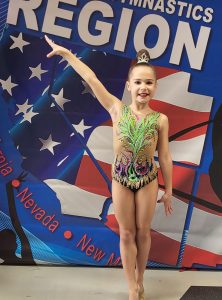About Rhythmic Gymnastics
Sport and Art together in harmony
Rhythmic Gymnastics, a symbiosis of art, aesthetic and beauty, paired with highest performances, is a true women's sport and belongs to the most attractive and beautiful disciplines. Femininity and elegance as well as the artistic expression of the gymnasts never fail to fascinate the public.
Rhythmic Gymnastics as a compositional discipline is the connection of the most difficult acrobatic movement elements which require a very high corporal flexibility and motor activity and which are presented by the gymnasts in perfect harmony with the music chosen for the exercise.
Rhythmic gymnastics is an Olympic sport that combines ballet, dance, and acrobatics, with expressive movement and apparatus manipulation of the ball, clubs, hoop, ribbon, and rope. This sport is perfectly balanced for developing flexibility, strength, and hand/body-eye coordination. It has been used for years in Europe as part of the physical education in schools.
This elegant form of gymnastics came into being as an illustration of expression through movement toward the end of the 19th and early 20th centuries. The discipline uses dance elements to develop aesthetic expression and grace in the human body.
Is Rhythmic a new discipline? Not quite. Scholars recently concluded that the sport can be traced back more than 3,500 years to ancient Egypt!
Timeline
- Early 1900s: The Swedish School of Rhythmic Gymnastics began the first rhythmic program.
- 1940: The first competitive rhythmic program was developed in the Soviet Union.
- 1963: The first world championship was held in Budapest, Hungary.
- 1967: The group exercise was introduced in Copenhagen, Denmark. The group exercise involved all the components of rhythmic, but also added the challenge of synchronizing movements and tosses between three to five girls on the floor.
- 1984: Rhythmic was finally introduced into the Olympic Games, which were hosted by Los Angeles, CA. This was the year that many Eastern European countries were forced to boycott the Olympics. Canadian Lori Fung took home the first gold.
- 1996: Group event was added to the Olympics.
It is in Sacramento now!
There are no vaults or bars to leap off. It’s just you, the music and one piece of apparatus that brings your performance to life. If you love expressing yourself to music, there is not better feeling. You must love to dance and creativity goes a long way. As you are taking your first step, you will learn how to move gracefully with five apparatus. You will start putting more complex moves together into mesmerizing floor routines. If you want you can compete or just have fun and fitness as you go.
Ready to become a rhythmic gymnast? Our club provides a safe and friendly environment with professional coach to help you learn.


Magic Words of Rhythmic Gymnastics











Individual program consists of four (4) optional routines. The five apparatus are rope, hoop, ball, clubs and ribbon. Every two years one event in rotated out of the program. At early levels, there may be a floor routine.
The group program consists of two routines. In the Junior Olympic program the groups perform a floor routine and an apparatus routine according to the apparatus rotation set by USA Gymnastics. Internationally the program consists of one routine with 5 of the same type of apparatus and one routine with two types of apparatus as set by the International Federation.
An individual routine consists of a maximum of 12 difficulties.
Each apparatus event has a special group of elements that are specific to that apparatus. Rope – Jumps/Leaps, Ball – Flexibility, Clubs – Balances, Ribbon – Pivots, and Hoop is an equal distribution of all special groups.
There must be a minimum of 6 special elements, which are named Compulsory Body Group Difficulties (GCOs) in each routine. And no more than 2 from each of the other groups which are called Non-compulsory Body Group Difficulties (non-GCOs).
Each gymnast must complete a score form and submit to the judges prior to competition. No gymnast is allowed to compete without the form.
The Junior Olympic Program (levels 3-8) is a development curriculum in the United States designed to prepare girls for the international program.
Score is calculated with the following formula: (Difficulty score + Artistry score)/2 + Execution
Difficulty: This part of the score is made of the Compulsory and Non-Compulsory groups.
Execution: This part of the score includes all penalties or deductions based on “how well” the routine was performed. For example, amplitude, bent knees, pointed toes, wobbles, drops and much more. The exact deductions may be found in the FIG Code of Points.
Artistry: This part of the score is the Music and the Choreography of the routine.
All routines must be performed with music, only short pauses are allowed.
Music can be a single or many instruments as well as voice (without words).
Noises like glass breaking, car engines, and plane noises are not allowed.
The musical composition should have a guiding theme
The musical themes must relate to each other and not have too many differences as to create a potpourri of music.
Every gymnast must have their music on separate tapes or CDs.
The choreography must have a main idea that is developed from beginning to end using a variety of body movements and apparatus handling.
In every routine there should be a variety in the way the apparatus is used. In other words different tosses, catches and interesting movements.
Also a variety in body movements and means of moving around the floor. The gymnast should not just walk around the floor. Dance is an important factor in the choreography.
Every routine should have a balance of work with both the Right and Left hands.
Acrobatic elements are limited to walkovers, cartwheels, rolls and movements that do not stop in the vertical position or show any flight.
Mastery is the term given to the large tosses and catches of the apparatus.
Originality elements are new and interesting work with the apparatus or with the connections between difficulties. All Originality elements are submitted to the International Federation for validation.
All leaps and jumps must include a few basic qualities: good height, clear and fixed shape, good amplitude.
All “Ring” shapes must have the foot in contact with the head.
All leaps with the back arched must have the head in contact with the leg.
Leaps with a turn, the turn must be completed from the take off until the landing.
Scissor leaps must have a switch of the legs – either forward or backward.
Fouette jumps do not have a switch of the legs.
All balance difficulties must have a few basic qualities: must be performed on the toes or the knee, to be held clearly and have a good fixed shape. The balance must have amplitude and be coordinated with a minimum of two apparatus movements (Technical Movements).
Balances performed on either a straight or bent knee doesn’t change the value of the balance.
During balances that rotate such as the Tour Lent, it is sufficient to just have the apparatus in motion throughout the balance.
All pivot difficulties must have a few basic qualities: have an exact shape from beginning to the end of the rotation and have good amplitude.
The level of difficulty of the pivot is determined by the degrees of rotation.
Pivots performed on bent or straight support leg doesn’t change the value of the pivot.
The FIG Technical Committee doesn’t approve of pivots on the knee.
All “ring’ shapes in pivot must have the foot in contact with the head.
During Penche pivots, the body must be held at horizontal throughout the entire pivot.
As a rule, the pivot combinations must be performed entirely on toes without heel support.
All flexibilities and waves must have a few basic qualities: be performed on 1 or 2 feet or on another part of the body, have an exact fixed shape ( a long pause in the position) and to have good amplitude.
The apparatus must stay in motion throughout all elements that move and if the flexibility is one in which the shape “stops” the apparatus must perform 1 Technical Movement.
